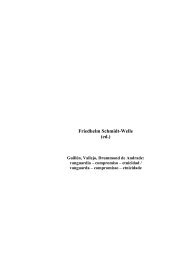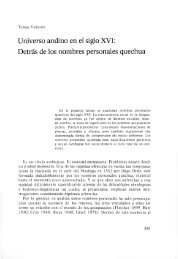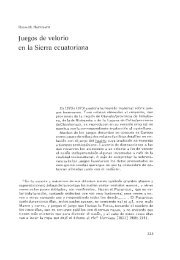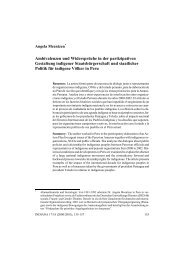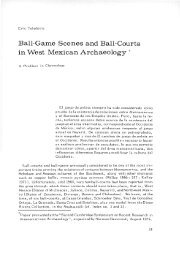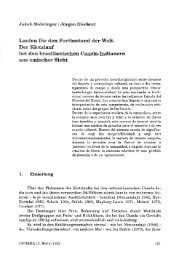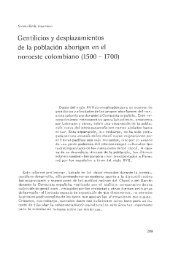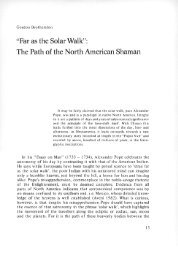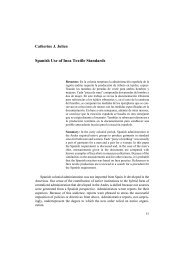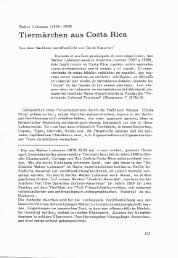Time and Script in Ancient Mesoamerica
Time and Script in Ancient Mesoamerica
Time and Script in Ancient Mesoamerica
Create successful ePaper yourself
Turn your PDF publications into a flip-book with our unique Google optimized e-Paper software.
that while a given shape, or 'component' may early be fixed as a concept,<br />
or as a word, or even a syllable, it will appear among others where such<br />
correspondence is looser or of a different order. Moreover, the cont<strong>in</strong>uity<br />
of such shapes <strong>in</strong> syntactical terms, <strong>and</strong> their sequence, i.e. read<strong>in</strong>gorder,<br />
rarely developed <strong>in</strong> such a way as to produce writ<strong>in</strong>g as we can recognize it.<br />
In this, Ch<strong>in</strong>ese ideograms, Babylonian cuneiform <strong>and</strong> Egyptian hieroglyphs<br />
must historically themselves be held exceptional. In each of these scripts<br />
we may witness a long process of formation <strong>and</strong> regularization, as the concepts<br />
<strong>and</strong> categories of thought <strong>and</strong> speech v^ere graphically ordered. Of<br />
course, this process was not always one way historically (towards phonetics)<br />
or logically, graphic design doubtless hav<strong>in</strong>g affected thought <strong>and</strong> word.<br />
But how special a phenomenon this regularization was can best be judged by<br />
the fact that the many alphabets of the modern world probably all come<br />
from a s<strong>in</strong>gle source.<br />
What we have seen of the Maya classic <strong>in</strong>scriptions must suggest that the<br />
script used <strong>in</strong> them presents a contrast on almost all these po<strong>in</strong>ts. Maya<br />
script appears all at once, ready formed, of well def<strong>in</strong>ed components, regularly<br />
arranged, <strong>in</strong> texts which are always dist<strong>in</strong>guishable as such. Of course<br />
there are differences between the monumental texts of the classic period <strong>and</strong><br />
the codices of the centuries immediately before the European conquest. But<br />
the essential characteristics of the system are there from the start. As<br />
Thompson has noted, we have no evidence whatever of stages of evolution<br />
prior to first appearance. It is possible, but unlikely, that other forms of<br />
Maya script, <strong>in</strong> this strict sense, preceded the one we know about, <strong>and</strong> are<br />
no longer extant. On present evidence, the least that we may assert is that<br />
Maya script, as we know it <strong>and</strong> <strong>in</strong> its <strong>Mesoamerica</strong>n context, appears to<br />
have depended for its existence, <strong>in</strong> the first <strong>in</strong>stance, on the Long Count.<br />
The Maya decision, then, to make arithmetic, astronomy <strong>and</strong> the calendar<br />
formally consistent with each other with<strong>in</strong> the Long Count must be recognized<br />
for the <strong>in</strong>tellectual development it provoked over <strong>and</strong> above the capacity to<br />
reckon astronomy <strong>and</strong> history <strong>in</strong> days <strong>and</strong> dates.<br />
By mak<strong>in</strong>g a day <strong>in</strong>to a unit the Long Count produced three fundamental<br />
categories of formal expression: first, the 'ma<strong>in</strong> sign', for the calendar<br />
names of the day (with<strong>in</strong> Sacred Round <strong>and</strong> month) <strong>and</strong> for day <strong>and</strong> vigesimal<br />
quantities of days; second, the affix, attached to one of the four sides of the<br />
squarish circle of the ma<strong>in</strong> sign, as its numerical co-efficient or specifier,<br />
<strong>and</strong> later as a particle of non-arithmetical grammar; third, the place or area<br />
to which comb<strong>in</strong>ations of ma<strong>in</strong> sign <strong>and</strong> affix, or glyphs, belonged, at first<br />
the rigorous position of arithmetic. As a system Maya script may fairly be<br />
said to be based on these categories, ma<strong>in</strong> sign, affix <strong>and</strong> glyph place, each<br />
of which is at least partly def<strong>in</strong>ed by the others. (Useful thoughts on this k<strong>in</strong>d<br />
of def<strong>in</strong>ition, though <strong>in</strong> other contexts, are <strong>in</strong> Foucault 1970).<br />
By enclos<strong>in</strong>g of the twenty radical elements of <strong>Mesoamerica</strong>n culture as<br />
'ma<strong>in</strong> signs', the Maya made not just counters of them but conceptual identities,<br />
calculiform (to recall Brasseur de Bourbourg's epithet) <strong>in</strong> the fullest<br />
22



